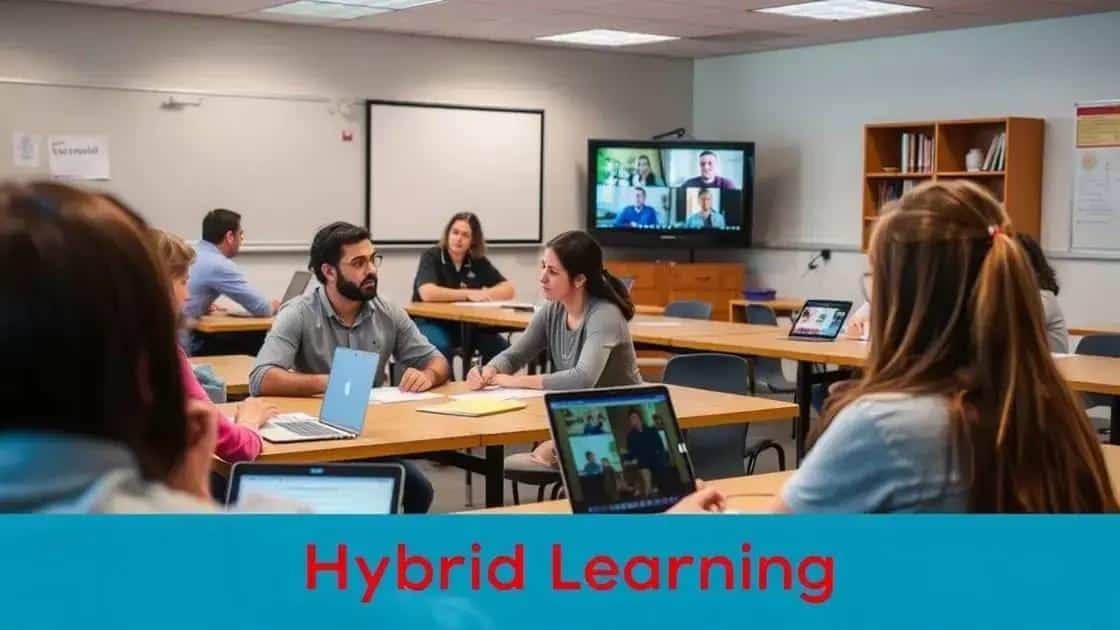Insights on hybrid learning success: a comprehensive guide

Assessing the success of hybrid learning programs involves gathering student feedback, measuring learning outcomes, utilizing technology analytics, and conducting longitudinal studies to ensure continuous improvement and effective educational strategies.
Insights on hybrid learning success can open doors to a more flexible and effective educational experience. Have you ever wondered how a blend of in-person and online learning can transform your classroom dynamics? Let’s dive into these insights together.
Understanding hybrid learning methodologies
Understanding hybrid learning methodologies is essential for creating effective educational environments. This approach combines traditional face-to-face instruction with online learning, allowing for a more flexible and engaging experience for students.
In a hybrid learning model, students have the opportunity to learn at their own pace while still receiving the support of their teachers. This flexibility can lead to improved student engagement and satisfaction.
Types of Hybrid Learning Models
There are several models that schools and institutions can adopt when implementing hybrid learning:
- Blended Learning: This model integrates online digital media with traditional classroom methods.
- Flipped Classroom: Homework and lectures are reversed, with students learning content online and engaging in activities in class.
- Flex Model: Students learn primarily online but attend physical classes periodically for support and hands-on activities.
Each model offers unique benefits and can be tailored to meet the needs of different learners. By utilizing technology and in-person interactions, educators can create a supportive learning environment.
Furthermore, understanding how to implement these methodologies effectively can help in fostering collaboration among students. Activities that encourage teamwork can significantly enhance learning outcomes.
Effectiveness of Hybrid Learning
Research has shown that hybrid learning can lead to greater knowledge retention and deeper understanding of subjects. One reason is that students are often more motivated when they have control over their learning.
With hybrid methodologies, students can engage in diverse learning experiences, which cater to individual learning styles. This personalized approach not only promotes autonomy but also boosts confidence.
Ultimately, the success of hybrid learning hinges on the ability of educators to adapt their teaching strategies. Creating an inclusive atmosphere where all students feel valued can lead to higher achievement rates.
Key benefits of hybrid learning environments

Hybrid learning environments offer a range of advantages that enhance the educational experience for students. By combining in-person and online instruction, these models create flexible learning opportunities tailored to individual needs.
One key benefit is increased accessibility. Students can participate in classes from various locations, making it easier for them to attend, regardless of their circumstances. This accessibility allows more learners to engage with the material actively, which can lead to a greater understanding.
Enhanced Engagement
Another significant advantage of hybrid learning is the potential for enhanced student engagement. Through interactive online activities and face-to-face discussions, learners can connect in multiple ways. Engaged students are more likely to retain information and stay motivated.
- Variety of Learning Formats: Students can switch between lectures, group projects, and online quizzes.
- Immediate Feedback: Teachers can provide real-time feedback through online platforms.
- Peer Interaction: Hybrid models promote collaboration between students in different formats.
Furthermore, hybrid learning fosters independence and responsibility. Students must manage their schedules and take ownership of their learning. This autonomy prepares them for future academic and professional challenges.
In addition to these benefits, hybrid learning environments often lead to improved learning outcomes. By utilizing technology, teachers can track student progress and adjust their methods accordingly. This data-driven approach helps ensure that each student receives the support they need.
Cost-Effectiveness
Cost savings is another compelling advantage. Hybrid models can reduce infrastructure costs for schools and lower commuting expenses for students. This efficiency allows institutions to allocate resources more effectively and invest in technology enhancements.
As education continues to evolve, the advantages of hybrid learning environments will likely play a crucial role in shaping the future of teaching and learning. By emphasizing accessibility, engagement, and autonomy, these models provide an enriched educational experience for everyone involved.
Strategies for effective engagement in hybrid classes
Strategies for effective engagement in hybrid classes are crucial for promoting active learning. These strategies help students feel connected, whether they are learning in person or online.
One effective approach is to incorporate interactive tools. Utilizing platforms that allow students to participate in discussions through polls, chats, and Q&A sessions can enhance involvement.
Fostering Collaboration
Another strategy is fostering collaboration among students. Group projects that combine in-person and online participants encourage teamwork and peer interaction. This collaboration can happen through:
- Breakout Rooms: Small groups can work together on tasks.
- Discussion Forums: Online spaces where students can share ideas and feedback.
- Shared Documents: Collaborative tools that let students contribute in real-time.
Engaging students in these ways not only builds community but also helps them learn from one another. When students work together, they develop communication and problem-solving skills.
Additionally, using multimedia resources can boost engagement. Incorporating videos, podcasts, and interactive presentations keeps content exciting and caters to different learning preferences. This variety allows students to consume material in the way that suits them best.
Encouraging Feedback
Encouraging ongoing feedback is another essential strategy. Teachers can regularly check on student understanding through quick assessments or informal polls to gauge their thoughts on the lessons.
Creating opportunities for students to provide feedback on the course structure also promotes a sense of ownership. This encourages students to express their needs and preferences, which can lead to adjustments that enhance their learning experiences.
Ultimately, implementing these strategies in hybrid classes helps create a dynamic and engaging learning environment. With these methods, educators can support student success and foster an inclusive atmosphere.
Assessing the success of hybrid learning programs

Assessing the success of hybrid learning programs is essential to ensure they meet educational goals. Evaluating these programs helps educators understand what works well and where improvements can be made.
One key method for assessment is through student feedback. Gathering opinions from students about their experiences can provide valuable insights. This feedback can be collected through surveys, interviews, or informal discussions.
Measuring Learning Outcomes
Another important aspect is measuring learning outcomes. Educators can compare test scores and participation rates between traditional and hybrid classes to see how well students perform. Tracking these metrics helps identify trends over time.
- Standardized Tests: Use these to measure student understanding of the material.
- Engagement Metrics: Monitor how frequently students participate in discussions and activities.
- Completion Rates: Assess how many students complete their assignments and courses.
Additionally, observing classroom dynamics is a practical approach to evaluation. Teachers can assess how students interact in both online and in-person settings. Observations can highlight which teaching methods engage students effectively.
Technological tools also play a significant role. Many educational platforms provide analytics that can track student performance and engagement levels. These analytics allow teachers to adapt their approaches based on real-time data.
Longitudinal Studies
Conducting longitudinal studies can provide deeper insights into the long-term effectiveness of hybrid learning programs. By following students over multiple semesters, educators can see how hybrid formats influence retention and academic success.
Ultimately, diverse assessment strategies enable educators to gain a comprehensive view of hybrid learning program successes and challenges. By continuously analyzing these elements, schools can enhance their hybrid offerings and better support student learning.
FAQ – Frequently Asked Questions about Assessing Hybrid Learning Programs
Why is student feedback important in hybrid learning?
Student feedback helps educators understand learners’ experiences and identify areas that need improvement.
How can learning outcomes be effectively measured?
Learning outcomes can be measured by comparing test scores, participation rates, and completion rates in hybrid versus traditional classes.
What role does technology play in assessing hybrid programs?
Technology offers analytics tools that track student performance and engagement, providing valuable data for assessment.
Why are longitudinal studies beneficial for evaluating hybrid education?
Longitudinal studies track student performance over time, revealing insights into long-term effectiveness and trends in hybrid learning.





